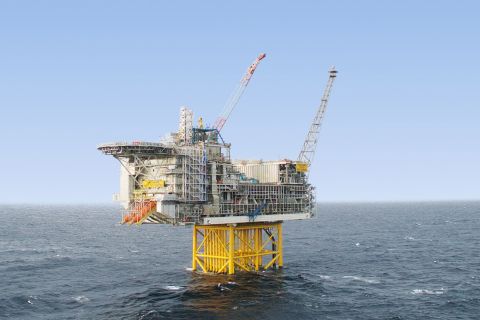[Editor's note: A version of this story and the video appear in the September 2020 edition of E&P Plus. Subscribe to the magazine here.]
While multiwell pad drilling offers many advantages, operators often find themselves relying on traditional methods that prevent them from experiencing the full benefits this approach can provide. New technology that reduces flat time can unlock deeper cost savings and efficiencies operators have been waiting for.
Traditional extraction methods involve drilling down vertically from a new pad into a single well. This requires a rig to be disassembled, hauled to the next pad and then reassembled—even if the new well site is just a few feet away. Relocating a rig requires several days, hundreds of thousands of dollars and constructing an entirely new drilling pad, along with all the equipment and infrastructure that goes with it, making it costly to the operator and the environment.
Multiwell pad advantages
Multiwell pad drilling enables operators to achieve economies of scale to shorten cycle time and increase rig productivity, which is why it has become the new norm in North America land operations. Instead of building multiple four-acre locations to drill, complete and produce horizontal wells, multiwell pad drilling allows operators to tap into different layers of shale at various levels of the subsurface at one time from one location, reaching multiple reservoirs and formations more efficiently. Multiwell pad drilling enables multiple wellbores to be drilled from one drilling pad, cutting down on the amount of space and the number of rigs needed for an operation, while increasing the number of wells, and potentially the amount of resources, those wells can reach.
Multiwell pad drilling is the multitasker of oil and gas production. There are simultaneous operations happening at one time. While an operator is perforating one well, they may be performing wireline on another well. Operations are completed in batches. These simultaneous operations can save hundreds of hours and thousands of dollars. What used to cost $10,000/hour using conventional methods, now costs about $3,000/hour with multiwell pad drilling. The overall cycle times and cost of drilling the well are dramatically reduced.
While multiwell pad drilling offers several compelling advantages, it can also create expenses for operators as field crews wait on site for their turn to perform their specific work. Production delays and increased planning can increase the complexity of employing multiwell pad drilling and can increase
labor costs.
Benefits of batching
The batch nature of multiwell pad drilling enables certain operations to be taken offline without affecting the overall economics or cycle time of the operation. Operators can skid over to the next well to begin rigging up while another well is cementing casing strings offline, for example. Taking cementing offline presents a viable option for operators to reduce nonproductive time (NPT), optimize drilling efficiency and reduce cycle time. Weir Oil & Gas’ Offline Cementing system gives operators valuable drilling time as it removes cementing from the critical path.
In the video above, Brandon Dodge, director of operations, Pressure Control, with Weir Oil & Gas, discusses offline cementing.
When taking cementing offline, the openhole section is drilled and casing is run to total measured depth and hung in the wellhead. The rig then skids to the next well, begins rigging up and drills the next openhole section. While the rig is setting up on the next well, the cementing can be performed on the previously drilled or cased well section.
Case study
Taking cementing offline can prove extremely fruitful, especially when it can be performed with both surface and production casing. A South Texas E&P company realized it was experiencing a significant amount of NPT due to waiting for cement to set. In an effort to reduce flat time, optimize drilling efficiency and reduce cycle time, the E&P company enlisted the use of the offline cementing system to take cementing operations safely off the critical path.
Weir designed and installed a compact, reliable and safe system that met cellar height requirements and attached it to the company’s S-29 Lock Ring Wellhead to enable offline cementing for production casing. It is a tool-free, eight-minute setup that eliminates the need for BOP configuration adjustments and enables testing isolation in the backside of the well for greater security and well integrity.

Once installed, the company’s cementing crew successfully connected its cement head to the system and completed the cementing operation. The offline cementing system resulted in a significant reduction in NPT and cost savings. The E&P company saved 8 to 10 hours of cycle time and about $32,000 per well with this solution. The offline cementing system also enabled the E&P company to manage crews with pinpoint accuracy, eliminating the typical NPT that is common in multipad drilling as crews wait for each other to complete each operation.
As companies seek to further reduce capex, taking advantage of automations (e.g., offline cementing) is more crucial than ever. Eliminating the NPT that occurs while field crews wait for their turn on site can create substantial cost savings and efficiencies.
Today’s climate is encouraging operators to challenge traditional approaches to see and do things differently—to take advantage of automation. Taking a systems-wide viewpoint helps unlock greater efficiencies and savings. By thinking in systems, not silos, improvements are identified that can impact the entire operation. Offline cementing is one of those improvements that can have positive ripple effects across a site.
Recommended Reading
OKEA Fast-tracking North Sea’s Brasse Tieback to Brage
2024-04-08 - OKEA expects first production in 2027 and has signed contracts with Aker Solutions, Subsea7 and OneSubsea.
E&P Highlights: March 25, 2024
2024-03-25 - Here’s a roundup of the latest E&P headlines, including a FEED planned for Venus and new contract awards.
NOD Approves Start-up for Aker BP’s Hanz Project
2024-02-27 - Aker BP expects production on the North Sea subsea tieback to begin production during the first quarter.
E&P Highlights: March 15, 2024
2024-03-15 - Here’s a roundup of the latest E&P headlines, including a new discovery and offshore contract awards.
E&P Highlights: Feb. 5, 2024
2024-02-05 - Here’s a roundup of the latest E&P headlines, including an update on Enauta’s Atlanta Phase 1 project.




